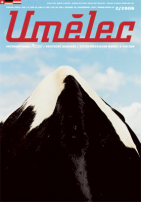| Revista Umělec 2006/2 >> Contacts of the Third Kind | Lista de todas las ediciones | ||||||||||||
|
|||||||||||||
Contacts of the Third KindRevista Umělec 2006/201.02.2006 Denisa Kera | Teoría | en cs |
|||||||||||||
|
Kontakt, Mumok, Vienna, March 17 – May 21, 2006
The Kontakt exhibition in Vienna shows a cross-section of middle-European art from the 1960s to the 1990s from the collection of the Erste Bank Group, which was founded within their Tranzit project. It shows works that were unable encounter each other because of the communist regimes, but yes still somehow “communicate” and follow common tendencies, particularly in conceptual art. This nearly telepathic contact joins the artists from the former Czechoslovakia to former Yugoslavia, Hungary, Poland, and works as a meeting of something close and familiar, but still unknown. The social and political revolutions that altered state borders and entire regimes. In this way expression. Conceptual art is always an “encounter of the conceptual inquiries into the borders of representation that have found their apt third kind” with what recalls objects and pictures and at the same time is not abstract or purely “worldly.” The borders of representation, in which “contact” continues and art as a whole doesn’t follow new techniques of painting or unusual combinations of visual styles, nor do they investigate objects. It is merely borders between what is visible and thinkable, which are fundamental to European tradition, juxtaposing thinking with light and visual metaphors. Conceptual art disturbs this intimate connection of thinking and seeing and looks for new forms of visual as well as ideological freedom. In the most formal form, Heinz Gappmayr, an artist comparing the creation of the meaning in language and art since the 1960s, investigates these borders of thinking and seeing. His work has the form of typographical experiments, in which language performatively does or denies what it says. The visual experience with the distribution of letters thus comes into connection with language meaning, e.g. in the work Will Be (wird, 1996), in which we can see a small movement, discontinuity of the last two letters, evoking thus the time experience of future. The next work North/South (Nord/Süd, 1962) throws the words on the page and creates unusual combinations out of them, which disturb our orientation. The typewriter in these works is not only a tool for poetry and literature, it has claims to be a tool of visual art just like a painter’s brush. A similar vision follows the conceptual poems of the Croatian artist Vlad Martek who creates the image of a poem with the help of pencil shavings glued to a page in the form of sonnets, or protests to the poetry kitsch of the 19th century by gluing a pen in the place where we would expect another line. A similar artistic approach is found in the deconstructive philosophy and visual minimalism in the work of Július Koller, who instead of usual pages uses offical forms and telegrams directly as a tool of artistic creativity. Famous is his green stamp which widens the image of the borders of conceptual art in the contact between "people-nature-objects-material." His universal fantastic objects and other forms of unidentified objects mimic James Joyce and bring further surprising connections between people and objects, nature and materials as the photo of an artist conducting a strange attack with a ping pong paddle. From the contemporary artists who connect to this tradition of surprising encounters of the third kind between people, material, objects and nature, Ján Mančuška and his While I Walked in My Studio in ISCP, 2005, is interesting. On a black rubber band which limits space, we read, with our steps we do the action and the trajectory the artist describes, and thus we become a co-creator of the art work. This surprisingly interactive form of conceptual art is shown in Peter Weibel’s work To Tread on Justice, 1967. Visitors write on it and at the same time they tread on the word JUSTICE written in chalk on the floor. This disappearing and renewing of concepts shows the dynamics of collective processes which rule our culture and civilization. The right, justice and other concepts are with every passing day always trampled to be renewed and to create a new meaning, system or rules out of indistinguishable smears on the floor. In this work there is a contact between people, language and the world that is a very contemporary form of an emergent and developing system.
01.02.2006
Artículos recomendados
|
|||||||||||||












Comentarios
Actualmente no hay comentariosAgregar nuevo comentario